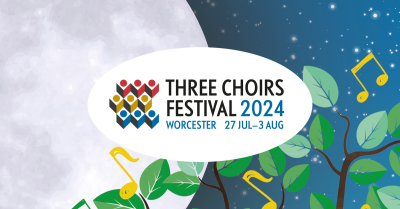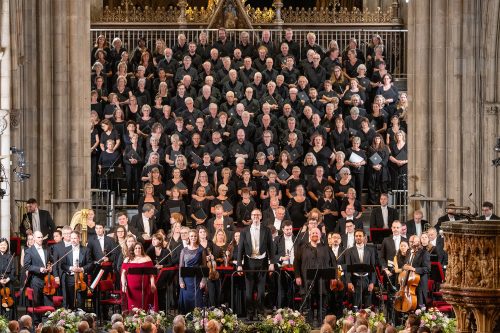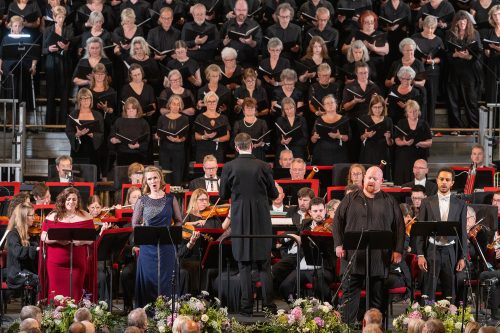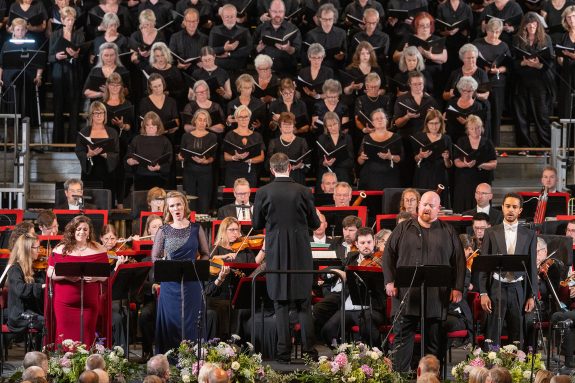
 United Kingdom Three Choirs Festival [1] – Grace-Evangeline Mason, Holst, Stanford: Rebecca Hardwick (soprano), Marta Fontanals-Simmons (mezzo-soprano), Nicky Spence (tenor), Themba Mvula (baritone), Three Choirs Festival Chorus, Worcester Cathedral Choristers, Philharmonia Orchestra / Samuel Hudson (conductor) Worcester Cathedral, 27.7.2024. (JQ)
United Kingdom Three Choirs Festival [1] – Grace-Evangeline Mason, Holst, Stanford: Rebecca Hardwick (soprano), Marta Fontanals-Simmons (mezzo-soprano), Nicky Spence (tenor), Themba Mvula (baritone), Three Choirs Festival Chorus, Worcester Cathedral Choristers, Philharmonia Orchestra / Samuel Hudson (conductor) Worcester Cathedral, 27.7.2024. (JQ)

Grace-Evangeline Mason – The Imagined Forest (2021)
Holst – The Hymn of Jesus (1917)
Stanford – Stabat Mater Symphonic Cantata, Op 96 (1906)
As befits its reputation as a bastion of the British choral tradition, it was very fitting that the first major concert of the 2024 Three Choirs Festival should feature music by two composers who have important anniversary years in 2024. The 150th anniversary of the birth of Gustav Holst (1874-1934) was honoured with a performance of one of his greatest works, The Hymn of Jesus, while the centenary of the death of Sir Charles Villiers Stanford (1852-1924) provided the spur for a revival of his Stabat Mater. Nor are these the only pieces by either composer on the Festival’s bill of fayre; further works by both of them will feature later in the week. However, before we heard the music of those two composers, we had the opportunity to experience a recent purely orchestral work.
The British composer, Grace-Evangeline Mason (b.1994) was co-commissioned by BBC Radio 3 and the Royal Liverpool Philharmonic Orchestra to write The Imagined Forest to mark the 150th anniversary of the Royal Albert Hall, London. The RLPO and their principal conductor Domingo Hindoyan premiered the piece at a BBC Prom in September 2021. On her website, the composer says this of her score: ‘The Imagined Forest… is a fantastical journey through a space that appears to be a familiar impression of nature, but simultaneously somewhere entirely unknown. The forest, a place rooted in fairy tales, fantasy and folklore, often represents areas of refuge, danger, transformation, and adventure. Recognising the forest as an ethereal and intangible entity, the piece seeks to momentarily transport the listener somewhere intimate and yet, surreal.’ She goes on to tell us that the piece ‘is inspired by the work of Clare Celeste Börsch, a Berlin-based artist who uses collage techniques to build imagined worlds filled with foliage and fauna. Bringing together thousands of delicate hand cut paper images, she creates intricate and immersive spaces to transform ordinary rooms into magical forests… The music follows a voyage through the forest with moments of florid energy marked by tumbling, intervallic passages enacting the liveliness of nature itself, contrasted with large interludes of static stillness embodying expansive clearings’. (The 2021 premiere was reviewed here by my Seen and Heard colleague, Colin Clarke, who admired the piece.)
The Imagined Forest takes about 14 minutes to play. It seemed to me, on a first hearing, that Samuel Hudson controlled it well and that the Philharmonia gave an excellent account of it. Mason’s music is harmonically and melodically attractive and I admired the assurance and imagination of her writing for what seemed like a large orchestra. She had referenced the ‘collage techniques’ of Börsch and it seemed to me that what I was hearing was a musical collage. The textures were interesting and colourful, well imagined for the orchestra. However, I was less sure of the trajectory of the piece. It began slowly and atmospherically; then the speed increased – though only to a moderate tempo – and gradually more instruments were added: eventually, the music subsided again. Beyond that, I got no firm sense of where the music was going. Whilst I should be interested to experience the piece again, my initial impression is that it is a bit too long for its musical material and premise.
The Hymn of Jesus is a work of blazing, visionary genius. I have had the good fortune to sing it in the past, so I know that to take part in a performance is a thrilling experience. Sadly, it is not performed as often as it should be. One reason for this may lie in the lavish scoring: Holst wrote for semi chorus, double SATB choir and a very substantial orchestra. He found his text in the Apocryphal Gospels and, as Andrew Burn pointed out in the programme, he was sufficiently motivated that he taught himself Greek specifically in order to translate the words into English. The hymn is rich in imagery and the language, as translated by Holst, positively invites a vividly colourful, ecstatic musical setting. Thus, the forces for which Holst wrote were not dictated by any kind of extravagance but by his burning desire to have the fullest possible range of colours to do justice to the text.
The performance had positive features but also some disappointments. The wonderfully atmospheric Prelude is founded upon two plainchant melodies: ‘Pange lingua’ and ‘Vexilla regis prodeunt’. Snatches of both hymns are sung by the semi chorus which were positioned off to the sides. The singers, from the choir of Worcester Cathedral, sang very well and the effect of their unseen voices, coming from a distance, was excellently judged. The Worcester choristers went on to play an important role in the rest of the work.
The Hymn itself explodes into life with a great choral outburst, ‘Glory to Thee, Father’. This, and subsequent repetitions of the same music, should pin the listener back in his or her seat. That effect wasn’t quite achieved tonight. I am not sure why. It may be that the Festival Chorus ideally needed another 20 or so voices to make the requisite impact in this acoustic but I wondered if Hudson galvanised them sufficiently. A little later, when the divine dance gets going (‘Divine grace is dancing’) the singing was good but I felt it wasn’t quite incisive enough and lacked the last ounce of rhythmic spring. That said, there were some good things from the Festival Chorus, not least the way in which some of Holst’s most audacious and imaginative harmonies were delivered (‘To you who gaze, a lamp am I’, as an example). Disappointingly, the ending of the piece, which should be hushed and mysterious, was rather too loud. Overall, I felt that this was a creditable performance of The Hymn of Jesus even if it didn’t fully live up to my expectations.
The Stabat Mater is among the series of substantial choral/orchestral works that Stanford composed in the late nineteenth- and early twentieth centuries for performance at the important musical festivals which were so prominent in British musical life at that time. Unfortunately, like so much of his music (other than his liturgical output), these choral works scarcely feature on concert programmes nowadays. His Requiem, first performed at the Birmingham Triennial Festival in 1897, is a noble work, as we can hear in Martyn Brabbins’ excellent recent recording (review here). There is also the Elegiac Ode, written for the 1884 Norfolk and Norwich Festival and the magnificent and substantial Te Deum, premiered at the Leeds Triennial Festival in 1898. I had never heard either work until they appeared together recently on a very fine CD conducted by Adrian Partington, one of this week’s Three Choirs conductors; the Te Deum is a particularly important discovery (review here). The Stabat Mater was also unveiled at a Leeds Festival, in 1907 – Stanford was the Leeds Festival conductor from 1898 until 1910. Like the other three aforementioned works, I have never had the chance to hear this work in concert until now; I know it only through the two fine recordings conducted by Richard Hickox and by David Hill. I was thrilled, therefore, when I learned that Hudson had chosen it for this concert. I made a conscious decision, though, to follow my usual practice when reviewing a concert by not listening to either recording in advance so that I came to this performance with fresh ears.
Though they are settings of liturgical texts, Stanford clearly designed both the Requiem and the Te Deum as concert works. That is true, too, of the Stabat Mater; indeed, Stanford made the concert nature of this work particularly clear by designating it as a ‘Symponic cantata’. He set the whole of the medieval Latin text but since two of the work’s five movements are purely orchestral, this meant that he had to compress several stanzas into each of the three vocal movements. A feature of the Stabat Mater is that Stanford doesn’t give his soloists any significant aria-like passages to sing. Though the soprano has some prominent solo passages, especially, in the second movement, the quartet tend to sing as a unit, albeit with some brief solo opportunities. In all three vocal movements, the soloists and chorus have equal prominence: in his programme note, the Stanford expert Jeremy Dibble rightly referred to ‘the operatic way Stanford treats his four soloists and the chorus as a putative turba’.

The singing in this performance was of a high order but I must give equal prominence to the orchestra – because that is what Stanford does. The orchestra plays a hugely important role in the three vocal movements, adding important colourings and bringing out the thematic motifs which run through the score The orchestra sets the scene in a substantial Prelude which serves two purposes: it establishes the darkly dramatic tone of much of the music to follow – this is going to be a Big Piece (it lasts for some 45 minutes) – and it also introduces some thematic motifs that will recur later in the score; not the least of these is an expansive, generous melody first heard on the cellos. The third movement is entitled ‘Intermezzo’ but no one should be deceived into thinking that this signifies a movement which is light in character. On the contrary, the music begins in dramatic vein and though it becomes more lyrical later on, the tone is still darkly imposing. Perhaps this should not surprise since the movement comes immediately after the singers have sung the words ‘Dum emisit spiritum’ describing the death of Christ. I thought the Philharmonia played these two movements very well indeed – and Hudson conducted the movement – and, indeed, the work as a whole – with a fine sense of the drama. The Philharmonia’s contribution to the whole performance was outstanding.
The Festival Chorus came more into their own in the Stanford. The dynamic contrasts, which hadn’t quite been there in the Holst, were much more in evidence. I can’t believe for a second that these accomplished singers were daunted in any way by the technical challenges of the Holst, but Stanford’s choral writing is, perhaps, more grateful to sing and the Festival Chorus did a fine job. They made excellent contributions throughout, but nowhere more so than in the final movement. Here, Stanford begins with very dramatic music (‘Virgo virginum præclara’), moving through to the intensity of the Day of Judgement (‘In die judicii’). Hudson and his forces built this passage to a mighty climax, with the chorus giving their all. Then Stanford moves seamlessly into the expansive, lyrical music to which he sets the final stanza of the poem. Here, the poet speaks of the redemption of the soul (‘Paradisi gloria’) and Stanford sets these words radiantly. The Festival Chorus here offered warm, committed singing.
As I said, there are no significant set piece solos for the quartet. All four soloists did well. Rebecca Hardwick offered ardent, engaged singing, though for my taste the vibrato was overdone. The mezzo role is less prominent but Marta Fontanals-Simmons sang with warmth and evident sincerity. Nicky Spence, the best known of the quartet, sang with the ring and lyrical ease that I have come to expect from this fine artist. I don’t think I have heard baritone Themba Mvula before; his singing was firm and assured.
At the end of the performance there was a welcome silence before the audience gave both work and performance the warmest reception of the evening. I have waited the best part of thirty years to hear the Stabat Mater live and I was delighted to do so by way of this fine performance which, I thought, did Stanford proud. In the last couple of years, I have had the opportunity to hear a couple of Stanford’s operas (on CD). Neither has really convinced me and I have come increasingly to feel that he produced far better – and more operatically dramatic – music in works such as the Requiem, the Te Deum and the Stabat Mater. This highly committed performance cemented that view.
John Quinn
